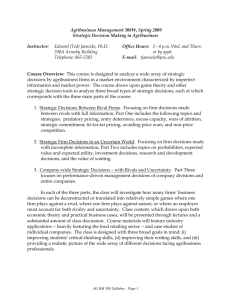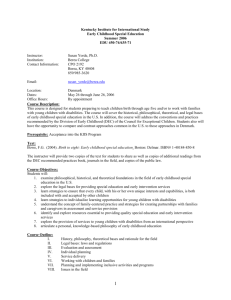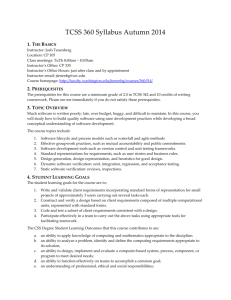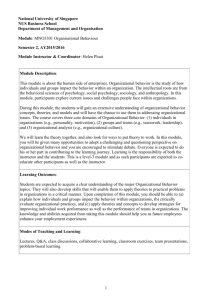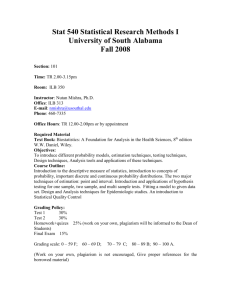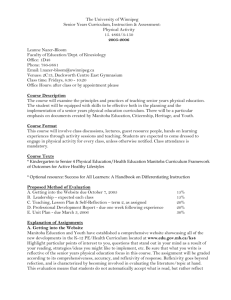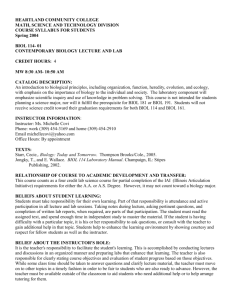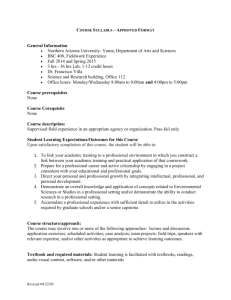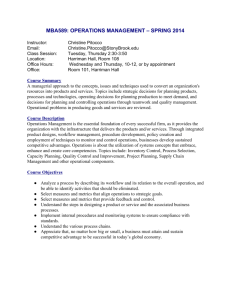Trends and Issues in Early Childhood Education
advertisement
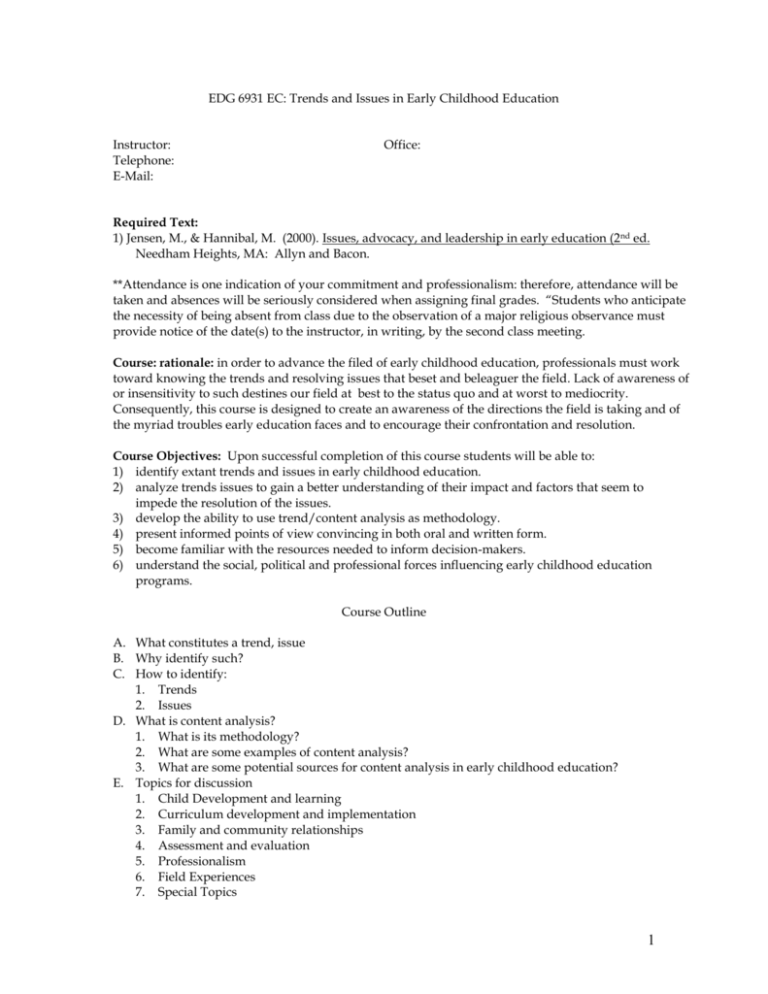
EDG 6931 EC: Trends and Issues in Early Childhood Education Instructor: Telephone: E-Mail: Office: Required Text: 1) Jensen, M., & Hannibal, M. (2000). Issues, advocacy, and leadership in early education (2 nd ed. Needham Heights, MA: Allyn and Bacon. **Attendance is one indication of your commitment and professionalism: therefore, attendance will be taken and absences will be seriously considered when assigning final grades. “Students who anticipate the necessity of being absent from class due to the observation of a major religious observance must provide notice of the date(s) to the instructor, in writing, by the second class meeting. Course: rationale: in order to advance the filed of early childhood education, professionals must work toward knowing the trends and resolving issues that beset and beleaguer the field. Lack of awareness of or insensitivity to such destines our field at best to the status quo and at worst to mediocrity. Consequently, this course is designed to create an awareness of the directions the field is taking and of the myriad troubles early education faces and to encourage their confrontation and resolution. Course Objectives: Upon successful completion of this course students will be able to: 1) identify extant trends and issues in early childhood education. 2) analyze trends issues to gain a better understanding of their impact and factors that seem to impede the resolution of the issues. 3) develop the ability to use trend/content analysis as methodology. 4) present informed points of view convincing in both oral and written form. 5) become familiar with the resources needed to inform decision-makers. 6) understand the social, political and professional forces influencing early childhood education programs. Course Outline A. What constitutes a trend, issue B. Why identify such? C. How to identify: 1. Trends 2. Issues D. What is content analysis? 1. What is its methodology? 2. What are some examples of content analysis? 3. What are some potential sources for content analysis in early childhood education? E. Topics for discussion 1. Child Development and learning 2. Curriculum development and implementation 3. Family and community relationships 4. Assessment and evaluation 5. Professionalism 6. Field Experiences 7. Special Topics 1 a. b. c. d. e. f. Abuse and neglect Poverty Financing early care and education Quality care Long-term outcomes of early education programs Media and Technology Evaluation: 1) written papers 2) oral presentations 3) class participation Assignments: 1. Trends paper (5 points) 2. Issues Paper (5 points) 3. Problems paper (5 points) 4. Content analysis paper ( 5 points) 5. Mid-term exam (5 points) 5. Discussion leader for one class (5 points) 7. Weekly one page discussion notes (5 points) 8. Final paper (10 points) 9. Participation (45 points) ADA Statement: Students with disabilities are responsible for registering with the Office of Student Disabilities Services (974-4309) in order to receive special accommodations and services. Please notify the instructor within the first week of classes if a reasonable accommodation for a disability is needed for this course. A letter from the USF Disability Services Office must accompany this request. USF Policy on Religious Observances: All students have a right to expect that the University will reasonably accommodate their religious observances, practices and beliefs. Students are expected to notify the instructor in writing by the second class if they intend to be absent for a class or announced examination, in accordance with this policy. Academic Dishonesty: Plagiarism is defined as “literary theft” and consists of the unattributed quotation of the exact words of a published text, or the unattributed borrowing of original ideas by paraphrase from a published text. On written papers for which the student employs information gathered from books, articles, or oral sources, each direct quotation, as well as ideas and facts that are not generally known to the public at large must be attributed to its author by means of the appropriate citation procedure. Citations may be made in footnotes or within the body of the text. Plagiarism also consists of passing off as one’s own, segments or the total of another person’s work. Punishment for academic dishonesty will depend on the seriousness of the offense and may include receipt of an “F” with a numerical value of zero on the item submitted, and the “F” shall be used to determine the final course grade. It is the option of the instructor to assign the student a grade of F or FF (the latter indicating dishonesty) in the course. Detection of Plagiarism: The University of South Florida has an account with an automated plagiarism detection service which allows instructors to submit student assignments to be checked for plagiarism. I reserve the right to 1) request that assignments be submitted to me as 2 electronic files and 2) electronically submit assignments to Turnitin.com. Assignments are compared automatically with a huge database of journal articles, web articles, and previously submitted papers. The instructor receives a report showing exactly how a student’s paper was plagiarized. For more information, go to www.turnitin.com and http://www.ugs.usf.edu/catalogs/0304/adadap.htm#plagiarism. Schedule Jan. 10 Overview of course Jan. 17 Issues/Trends/Problems discussion Jan. 24 Content Analysis Jan. 31 Feb. 7 Feb. 14 Feb. 21 Feb. 28 March 7 March 14 Spring Break March 21 March 28 April 4 April 11 April 18 April 25 3

